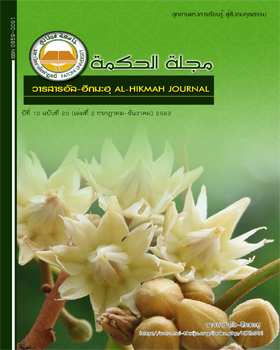Web Application Development According to Maqasid al-Shariah to Enhance Students’ Learning Competencies in 21st Century
Keywords:
Web Application, Maqasid al-Shariah, Enhance, 21st CenturyAbstract
Maqasid al-Shariah (MS) is a term that refers to the preservation of order, achievement of benefit and prevention of harm or corruption. This paper was aimed to assess the use of web applications in accordance with the MS of students in the 21st century. Moreover, System Development Life Cycle: SDLC included planning, systems analysis and requirements, systems design, development, integration and testing, implementation, and operations and maintenance. Likewise, three steps were developed by researchers in used. The sample were 128 students and teacher in Islamic private schools in southernmost Thailand. The instruments were included story of animation, video, and games as well as Visual Studio Code, XAMMP, Composer, MySQL, MySQL Workbench used to develop the web application. The findings found that the way of MS based on five basic needs to protect by Shariah/Islam included Ad Deen, Al Nafs, Al Aqal, Al Mal, and Al Nasab. Furthermore, the development web applications based on the MS were 15 animation cartoons, three videos, three whiteboard animation, and three games. Additionally, the assessment the use of web applications was used Kirkpatrick model is probably the best-known model for analyzing and evaluating. The four levels are reaction, learning, behavior, and result.
References
พยาบาลบรมราชชนนียะลา. The Southern College Network Journal of Nursing and Public Health, 6(1), 112-120.
ไฉน ผลดี. (2553). ระบบสารสนเทศเพื่อการบริหารจัดการโครงการโรงเรียนบ้านโนนยาง. วิทยานิพนธ์ วิทยาศาสตรหาบัณฑิต สาขาวิชาเทคโนโลยีสารสนเทศการเกษตรและพัฒนาชนบท. อุบลราชธานี: มหาวิทยาลัย
อุบลราชธานี.
ระวีวรรณ วงศ์พิมพ์. (2552). ระบบสารสนเทศเพื่อการจัดการเรียนการสอนผ่านอินเทอร์เน็ต กรณีศึกษาศูนย์
แพทยศาสตรศึกษาชั้นคลินิก โรงพยาบาลสรรพสิทธิประสงค์. วิทยาศาสตรมหาบัณฑิต สาขาวิชา
เทคโนโลยีสารสนเทศ. อุบลราชธานี: มหาวิทยาลัยอุบลราชธานี.
El Mawas, N., Bradford, M., Andrews, J., Pathak, P., & Muntean, C. H. (2018, June). A Case study on 21st century skills development through a computer based maths game. In EdMedia+ Innovate Learning (pp. 1160-1169). Association for the Advancement of Computing in Education (AACE).
Moore, A. F., Newman, D. J., Ranganathan, S., & Liu, F. (2019). Imaginative Order from Reasonable Chaos: Conformation-Driven Activity and Reactivity in Exploring Protein–Ligand Interactions. Australian Journal of Chemistry, 71(12), 917-930.
Raob, I., Hasan, F. A., & Jeha, Z. (2021, February). The Strategic Development for Research Excellence in Thailand 4.0 of Postgraduate students Under Council of the Graduate Studies Administrations of Thailand (CGAT). In Journal of Physics: Conference Series (Vol. 1779, No. 1, p. 012036). IOP Publishing.
Raob, I. (2012). Action Research (AR): Preparation to Quality Criteria. AL-NUR JOURNAL OF GRADUATE SCHOOL, FATONI UNIVERSITY, 7(12), 59-67.
Ruthmann, S. A., & Dillon, S. C. (2018). Technology in the lives and schools of adolescents. Music Learning and Teaching in Infancy, Childhood, and Adolescence: An Oxford Handbook of Music Education, 2, 313.
Islam, S., & Islam, N. (2006). Information and communication technology (ICT) in libraries: a new dimension in librarianship. Asian journal of information technology, 5(8), 809-817.
Majma’ al-Lughah al-Arabiyyah(2004). Mu’jam al- Wasit. Cairo: Maktabah al-Shuruq al-Dauliah, 4thedi..



